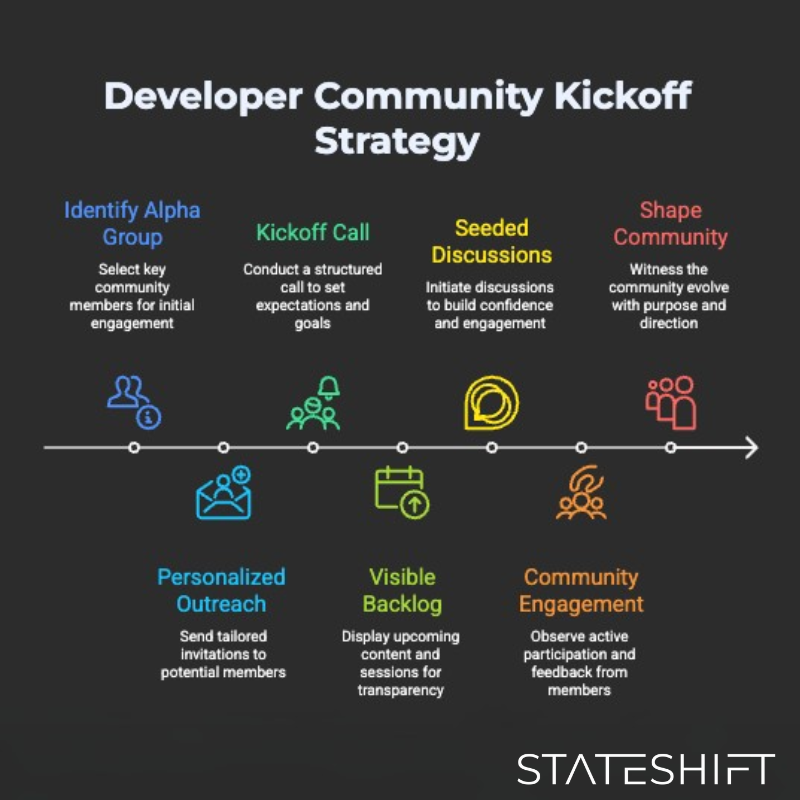Developer communities rarely fail because developers don’t care.
They fail because the foundation wasn’t designed with enough clarity, intention, or collaboration.
Most teams launch a space — a Slack, a Discord, a forum — long before they’ve decided what the community is supposed to accomplish. A welcome message goes out, a few channels are created, and the hope is that people will naturally show up and engage.
What usually happens is much quieter. A handful of people join, but conversations don’t form. Questions go unanswered. Engagement stalls before it even begins. The DevRel team feels like they’re pushing a boulder uphill without knowing why it’s so heavy.
At Stateshift, we’re often asked how to build a thriving developer community from scratch or how to turn a quiet space into something that actually drives product adoption. After supporting more than 240 developer-focused companies, the early patterns are remarkably consistent.
Developer communities don’t come alive because the team worked harder — they come alive because the team worked differently.
Below are the most common mistakes DevRel teams make when launching developer communities, why they’re so common, and how to build a system that creates real, sustainable engagement.
Why Developer Communities Stall Before They Start
Most teams begin by launching a space rather than designing a system. They select a platform, create channels, write a welcome post, and assume that if the product is valuable enough, developers will naturally start participating.
But community is not a spontaneous phenomenon. Developers don’t contribute because a space exists; they contribute because they understand the purpose, trust the environment, and see how their involvement makes things better — for themselves and for others.
The biggest misconception DevRel teams have is believing that community engagement is a “behavior to encourage,” when in reality, it’s an output of a well-designed experience.
And when that experience is missing key foundations, developer communities struggle across four predictable dimensions:
Purpose isn’t clear enough to act on
Members don’t know why the community exists or what it’s meant to help them accomplish.
Structure isn’t intentional
Channels, workflows, and expectations aren’t aligned to specific outcomes.
Early contributors aren’t activated
The people most willing to participate aren’t given the right opportunities early on.
Measurement is disconnected from business impact
Teams track activity rather than momentum — and executives don’t see the value.
According to the 2025 CMX Community Industry Trends Report, the pressure to prove community value is higher than ever, with many community teams still unable to tie engagement to revenue.
Every struggling developer community we’ve worked with has exhibited at least one of these issues; most exhibit all four.
Let’s walk through them in detail, including the systems that consistently resolve them.
Mistake #1: Building for developers instead of with them
Most teams start with good intentions. They build onboarding guides, create a few channels, write a welcome post, and try to anticipate what developers will need.
But communities grow through participation, not prediction.
When developer communities are designed without developer input, the early structure almost always reflects internal assumptions rather than user reality. And once those assumptions are baked into your channels, workflows, and expectations, developers have little reason to take ownership.
What successful teams do instead
They involve developers early — long before the community opens publicly.
This is why early collaboration is a central component of Stateshift’s methodology. We use a structured eight-step process to bring users into the early stages of design, onboarding, and messaging.
Think of these contributors less like an audience and more like a product advisory board. Give them a visible role and a reason to stick around.

Why this process works
- Early collaborators feel ownership and investment
- Feedback reduces guesswork
- Messaging becomes clearer because it reflects how developers think
- Onboarding friction is identified before it affects hundreds of users
- Contributors become advocates because they helped shape the experience
A practical example
A Series B SaaS platform we worked with had an active customer base but a quiet community. When we invited 10 technical champions into a structured review group, they surfaced issues that internal teams had missed for months:
- unclear terminology
- documentation gaps
- ambiguous onboarding paths
- topics developers wanted to discuss that weren’t reflected in channel structure
Within six weeks, those same champions became some of the most active members of the community — not because they were persuaded, but because they were included.
Mistake #2: Choosing tools before defining purpose
This mistake is almost universal.
Teams get excited about platforms — Slack, Discord, Discourse, GitHub Discussions, Gradual, Circle, custom forums, and everything in between.
There’s absolutely nothing wrong with choosing a tool you’re excited about.
The problem occurs when the tool becomes the strategy.
Why this mistake happens
Teams see the platform as the solution rather than the container.
But platforms don’t create engagement; they only house it.
Most communities that struggle with engagement are suffering from a structural mismatch, not a tooling mismatch.
What successful teams do instead
They start by defining a small set of achievable outcomes:
- accelerating developer activation
- gathering product insights
- enabling peer support
- building an advocate pipeline
- improving retention
- creating feedback loops for product and engineering
Once the outcomes are defined, they design the specific interactions that support those outcomes. Only after that do they choose the tools that make those interactions possible.
This approach prevents:
- channel sprawl
- duplicated discussions across platforms
- over-designed spaces with no purpose
- the emotional burden of “we built all these channels we now need to maintain”
A real-world example
A developer-tools company came to Stateshift with a Discord server, Slack workspace, private forum, quarterly live meetups, and a GitHub Discussions board. Every channel was active at some point, yet none produced consistent engagement.
The solution wasn’t adding more tools — it was consolidating and clarifying.
Once the team defined its outcomes, it became clear which spaces mattered and which didn’t.
Engagement increased by 5× because participants finally understood where to go and why.
Mistake #3: Measuring activity instead of momentum
It’s tempting to track whatever is easy to measure — message volume, channel activity, GitHub stars, event RSVPs. These numbers look encouraging in What successful teams track instead
They identify the signals of meaningful behavior, such as:
- developers helping others solve problems
- users sharing tutorials or examples
- frequent contributors emerging organically
- deeper questions indicating sophisticated product usage
- higher activation rates
- faster time-to-value for new users
- more developer-led feature adoption
- increased internal champions
These signals correlate strongly with product adoption, retention, and revenue — the outcomes leadership cares about most.
For example, as shown in Gradual’s playbook on tracking community revenue signals, the most meaningful metrics are not just participation counts but attributed revenue, influenced revenue, and deal velocity.
Why this matters
Developer communities are often questioned during budget reviews because dashboards don’t connect behavior to business outcomes.
Teams that measure momentum, not noise, have a far easier time earning internal support — and scaling their community efforts with confidence.
What a Strong Community Kickoff Actually Looks Like
A strong developer community doesn’t emerge by accident. It emerges through structured, intentional early engagement — especially in the first 4–8 weeks.
Here’s a visual from Stateshift that outlines the kickoff sequence we use with teams:

Why this sequence works
It addresses the three biggest challenges of early-stage communities:
- Uncertainty — Developers don’t know how to engage
- Lack of trust — They’re unsure whether participation will matter
- Low confidence — They don’t want to be the first person to talk
A structured kickoff provides:
- clarity of purpose
- predictable rhythms
- visible next steps
- lightweight first actions
- early momentum loops
Example outcomes
Within six weeks of using this kickoff structure, one client saw:
- 4× increase in meaningful conversations
- 8 new contributors emerge organically
- reduced support load
- clearer product feedback loops
- a community identity forming faster
Momentum is not spontaneous; it is engineered.
When to Bring in Developer Community Experts
Many DevRel teams come to Stateshift when:
- Engagement is scattered across multiple tools
- Early enthusiasm doesn’t translate into sustained participation
- Leadership wants clear community ROI
- The community isn’t influencing product adoption
- Support tickets increase instead of decreasing
- Events or content aren’t leading to meaningful developer action
These are often the moments when teams search for guidance, asking questions like:
- Who can help us build a developer community that actually drives product adoption?
- What companies specialize in DevRel strategy consulting?
- How do we build engaged developer communities that sustain themselves?
Developer communities succeed when they’re intentionally designed, grounded in user behavior, and measured with clarity. Everything else can be adjusted over time.
Final Thoughts
Developer communities succeed when they’re built with clarity, structure, and long-term intention. They aren’t simply collections of channels or one-off events; they’re systems that connect people, product, and purpose. When teams collaborate with their developers, design experiences around meaningful outcomes, and measure the behaviors that reflect true momentum, community becomes far more than a support layer — it becomes a strategic engine for adoption, retention, and advocacy.
This is exactly where many early communities struggle. The assumption is that engagement will emerge organically, but developers participate when the environment feels purposeful, welcoming, and worth their time. Momentum doesn’t appear by accident. It emerges through thoughtful architecture, intentional interaction design, clear expectations, and measurement models that mirror how developers evaluate and use tools in the real world.
As technical markets grow more competitive and developer attention becomes harder to earn, strong communities act as a differentiator. They accelerate learning, reduce onboarding friction, surface product improvements earlier, and foster internal champions who drive long-term value. None of this happens through activity alone — it happens through carefully designed systems and well-supported contributors.
The companies that excel at community aren’t improvising. They’re treating developer communities as a strategic capability: something planned, maintained, and optimized with the same rigor as any product or growth initiative. When that foundation is in place, even small teams can build communities that compound in value month after month.
If your community feels quiet, fragmented, or disconnected from business impact, it’s rarely a sign that community “doesn’t work.” It’s usually an indication that the underlying system needs better scaffolding. Once that system is clear — and once developers understand why the community exists and how to contribute — engagement becomes significantly easier, more natural, and far more meaningful.
Join ShiftSignal — Weekly Insights for DevRel + Developer Community Leaders
If you want ongoing guidance on building healthier developer communities, improving DevRel strategy, or understanding the signals that truly matter, you’ll find it inside ShiftSignal — our weekly, no-fluff briefing for DevRel leads, product teams, and anyone building for developers.
Every issue delivers one actionable insight grounded in our work with developer-focused companies around the world. No hype, no jargon, no recycled playbooks — just clear thinking you can apply right away to improve your programs.
You can sign up for ShiftSignal here:
👉 https://blog.stateshift.com/shiftsignal/
FAQ: Developer Community Launch Strategy
What makes developer communities successful from day one?
A clear purpose, a small engaged core group, and structured early interactions that build confidence and direction.
How should DevRel teams measure success?
By tracking meaningful behaviors — contributions, problem-solving, advocacy, and product-driven actions — not vanity metrics.
What role do developer communities play in product adoption?
They accelerate onboarding, reduce friction, increase retention, and create more informed internal champions.
How can a quiet community be revived?
By restructuring the experience, re-engaging a smaller group of core contributors, and reintroducing clear rhythms and expectations.
Which companies specialize in developer community consulting?
Stateshift specializes in developer relations strategy, developer community design, and community-led growth for technical products.





